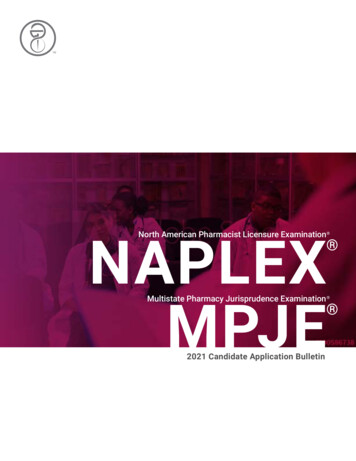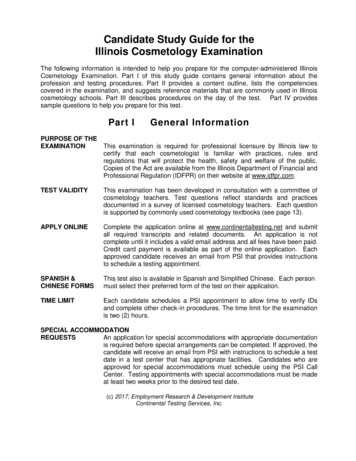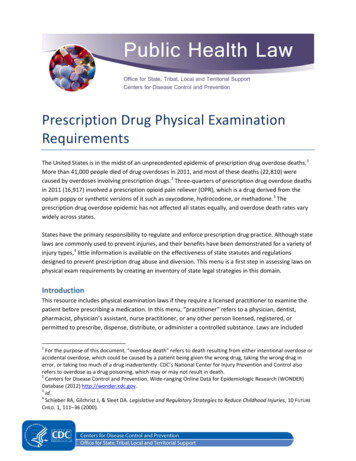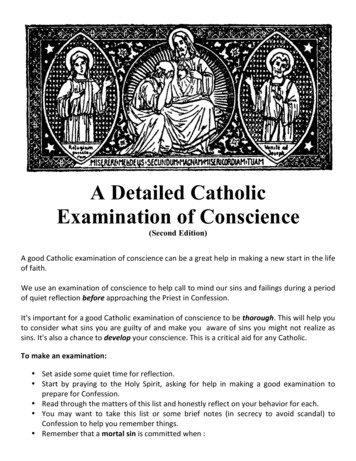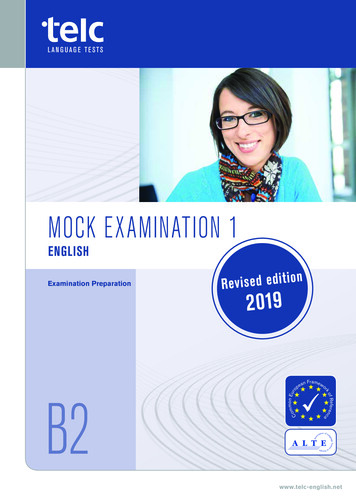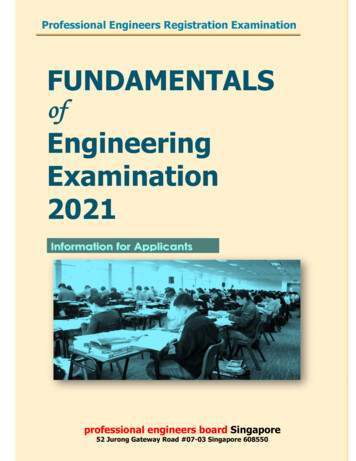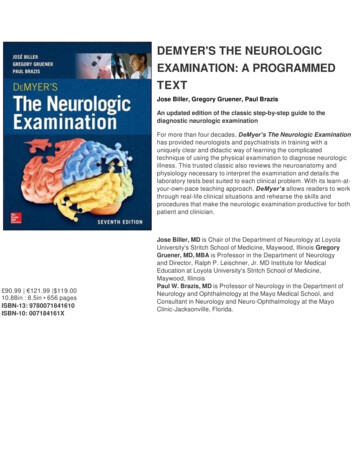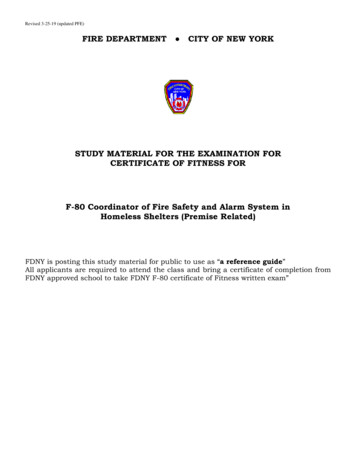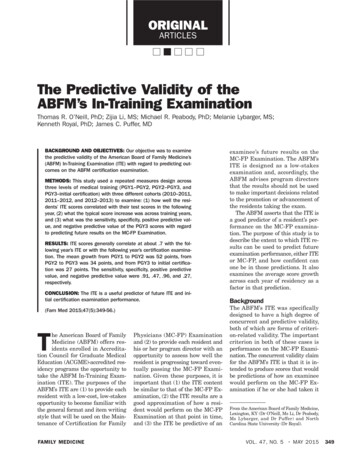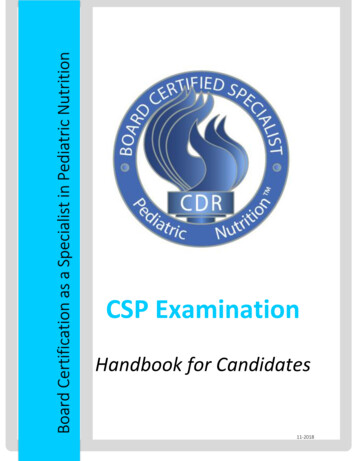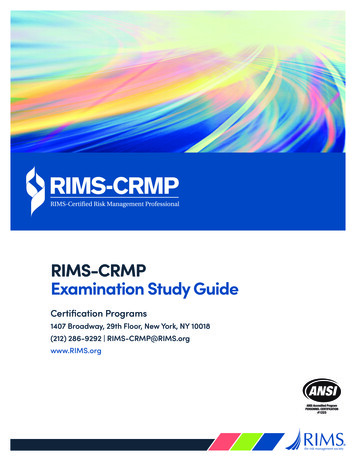
Transcription
RIMS-CRMPExamination Study GuideCertification Programs1407 Broadway, 29th Floor, New York, NY 10018(212) 286-9292 RIMS-CRMP@RIMS.orgwww.RIMS.org
RIMS-CRMP Examination Study GuideTable ofContentsIntroduction. 2Section 1 – Background and Process. 3About the RIMS-CRMP Certification. 3Study Strategies. 3Approaches to Memory and Retention. 4Strategies for Analysis of an Exam Question. 4General Strategies for Taking the Exam. 5Test Preparation Strategies. 6What to Expect at the Testing Center. 6Section 2– Examination Blueprint and Review Components. 9Examination Blueprint. 9Review Components. 10Section 3– Review. 11Analyzing the Business Model. 11Designing Organizational Risk Strategies. 15Implementing Risk Process. 18Developing Organizational Risk Competency. 21Supporting Decision Making. 23Appendix A. 26Glossary. 28References. 29Tables andFiguresFigure 1 Generic Labeled Example of a 4-Choice Multiple-Choice Item. 4Table 1 Domains and Key Duties. 9Figure 2 Graphical Representation of Domains within the Certification Curriculum. 10Table 2 Sample Self-Assessment Checklist. 12Table 3 Self-Assessment for the Domain Area of Analyzing the Business Model. 13Table 4 Self-Assessment for the Domain Area of Designing OrganizationalRisk Strategies. 16Table 5 Self-Assessment for the Domain Area of Implementing Risk Process. 19Table 6 Self-Assessment for the Domain Area of Developing OrganizationalRisk Competency. 22Figure 3 Risk Management Decision Making Environments. 24Table 7 Self-Assessment for the Domain Area of Supporting Decision Making. 25 2021 Risk and Insurance Management Society, Inc. All rights reserved.1
RIMS-CRMP Examination Study GuideIntroductionThank you for your interest in the RIMS Certified Risk Management Professional (RIMS-CRMP) examination administered byRIMS, the risk management societyTM.In order to qualify for the RIMS-CRMP examination, you must meet the eligibility requirements detailed in the CandidateHandbook, and listed on the RIMS-CRMP website. The Candidate Handbook provides detail on eligibility requirements,examination logistics, recertification requirements, the Code of Ethics and additional policies. The Candidate Handbook isavailable on the RIMS website at:http://go.rims.org/2021handbookThe purpose of this document is to serve as a study guide for anyone who is taking the RIMS-CRMP certification examination.It is not intended to replace any textbook or other resources you need to prepare for the examination, and using this guidedoes not guarantee that you will pass the examination. The study guide is divided into two sections. The first section deals withthe background of the CRMP designation and provides guidance on the process of studying, taking examinations, and what toexpect at the testing centers.The second section summarizes five core competencies of a risk professional:1. Analyzing the Business Model2. Designing Organizational Risk Strategies3. Implementing Risk Process4. Developing Organizational Risk Competency, and5. Supporting Decision Making.It then reviews each of the core competencies based on five review components:1. Learning objectives2. Examples3. Recommended reading4. Self-assessment of content areas, and5. Sample exam questionsThe study guide concludes with a glossary of terms and bibliography. 2021 Risk and Insurance Management Society, Inc. All rights reserved.2
RIMS-CRMP Examination Study GuideSection 1 - Background and ProcessAbout the RIMS-CRMP CertificationAs the preeminent organization dedicated to advancing the practice of risk management, RIMS is a global not-for-profitorganization representing more than 3,500 industrial, service, nonprofit, charitable and government entities throughout theworld. Founded in 1950, RIMS brings networking, professional development and education opportunities to its membership ofmore than 11,000 risk management professionals who are located in more than 60 countries.The RIMS-CRMP certification distinguishes the achievement of validated risk management competencies of an effective riskmanagement professional. The RIMS-CRMP is based on a job task analysis completed by dozens of experienced riskmanagement experts. It has been statistically and psychometrically validated by a global representation of RIMS members.Achieving the RIMS-CRMP credential represents a unique combination of experience, demonstrated knowledge and competencyin risk management, and dedication to upholding high standards of ethical and professional conduct. Individuals who earn andretain the RIMS-CRMP certification are required to: attest to the certification requirements through an application, providesupporting documentation, pass a rigorous exam, uphold an established Code of Ethics and meet continuing educationrequirements in order to maintain the certification. Typically RIMS-CRMPs have expertise in a specific field of risk managementand want to differentiate themselves as an acknowledged professional by earning the RIMS-CRMP certification.RIMS-CRMPs may use the credential to establish credibility within their organizations, among other professionals and withthe public. Adding the RIMS-CRMP certification to your professional profile demonstrates that you have achieved a high levelof competency through validated expertise, education and experience to successfully manage risk and create value for yourorganization. So how do you begin?Study StrategiesPeople review and process information in different ways. Some individuals find memorization easy, while others sort factsinto a contextual framework. The RIMS-CRMP examination requires that you know factual data and use the information indecision-making and in problem-solving situations.Learning styles differ. Some individuals prefer to study alone, while others prefer a study partner or study group. Discussinginformation with a partner or in a group can help clarify, process and integrate information. Some individuals learn better byhearing information, while others learn better by reading or writing information.Research methods vary. How do you tackle unfamiliar topics? If you hear about something exciting and want to learn more,how do you go about finding information? Do you read about it, take a class, call an expert and ask for a demonstration, orpurchase equipment and teach yourself? Some prefer one method over another. For example, if you chose to ask an expert,then you may prefer a hands-on approach where you can safely experiment (trial and error) and get input and feedbackfrom someone knowledgeable in that area. Others choose a combination of methods. For example, you can attend courses,view webinars that can be repeated, highlight texts or write flash cards that can be reviewed.Study groups can drive accountability. Whoever leads the group may utilize this study guide and/or additional resources.A group of people can talk through ideas, provide examples and support each other in their learning endeavors.Formulate a study strategy and schedule sufficient time to prepare. You are the best judge of your study preferences, so usewhat works best for you. 2021 Risk and Insurance Management Society, Inc. All rights reserved.3
RIMS-CRMP Examination Study GuideApproaches to Memory and RetentionThis section outlines some tips for memorization and retention. While the RIMS-CRMP examination is not based on“rote-learning” and memorization, using these types of techniques can prove effective to remember and recall pertinent concepts and facts. These techniques may help in preparing for this exam, as well as help you for other learning purposes.Memorization and recall is a key component of studying. While you may already possess the practical knowledge, recalling itduring a time of stress may prove challenging.One key strategy to recalling information is to self-test. As you compile and address content areas from the exam, a theorycalled “the testing effect” shows that learning is enhanced by the act of recalling information after exposure (Dobson, J.L. andLinderholm, 2015). This simply means that by reading information, recalling and reviewing as much as possible (self-test) andthen re-reading the information, retention was found to be greater than just reading and taking notes.Other techniques associated with recalling information are:1. Get organized. Organize notes according to domain and content area. Find a quiet, uncluttered space in which to study. Ifyou are studying in a group, make sure the group space is free from distractions from outside noise, chatter and clutter.2. Make it meaningful. Create mnemonic devices to help recall formal names of concepts. Various types of devices includerhyming (I before E except after C ), names (ROY G BIV colors of the rainbow), or notecards. It’s also best, when possible, to relate a concept to a personal experience. If personal experience is attached, the concept holds more meaningtherefore it may be recalled more readily.3. Don’t cram. Spread studying out over several days or weeks. Study in chunks of time. Do not spend three, four, or fiveconsecutive hours studying. Take frequent breaks (every 20-25 minutes) to refresh and recuperate.4. Take notes and create flashcards. While most people have a laptop at their disposal, research shows that taking notesby hand is better than taking notes on a laptop for remembering conceptual information over the long term (Mueller,P,A. and Oppenheimer, D.M. 2014). The old-fashioned method of taking notes by hand forces you to synthesize information in ways that typing doesn’t.5. Get enough sleep. The right amount of sleep aids in better performance, mental agility and wards off stress. The brainconverts facts from short-term memory into long-term memory while sleeping.Strategies for Analysis of an Exam QuestionAll questions on the RIMS-CRMP examination are in the four-choice multiple-choice item type format. This item formatconsists of a stem, which is in the form of a question or incomplete statement, and four response options. Only one of theresponse options correctly answers the stem (the key); the other three options are incorrect (the distractors). When respondingto the questions on the RIMS-CRMP examination; you select ONLY one of the response options. Figure one depicts a genericlabeled example of a four-choice multiple-choice item. (Please note, this item is only representative of the format of the itemand DOES NOT represent the content on the RIMS-CRMP examination.)Figure 1Generic Labeled Example of aFour-Choice Multiple-Choice Item 2021 Risk and Insurance Management Society, Inc. All rights reserved.4
RIMS-CRMP Examination Study GuideThe questions on the RIMS-CRMP examination may vary in complexity. Some questions ask you to recall information (such as,“What is X?”) and some questions require you to apply knowledge in order to select the most appropriate response or actiongiven the situation in the stem. When responding to each question, you should always select the BEST option. You should alsopay close attention to the words in the stem, to determine what the question is truly asking, as the question may be askingwhat MUST be done or what is MOST commonly done vs. what CAN be done.Each question on the exam is written so that all four answers are plausible. If this was not the case, and the incorrect answerswere implausible, then your knowledge would not be effectively measured. The exam does not use “trick” questions. Instead youmust either know the data or be able to effectively apply the data in a decision-making process to choose the BEST answer.All questions and answers are referenced to a recognized and accepted textbook or resource. Each question has beenreviewed by a number of experienced professionals in the field who agree on the correct answer. In addition, a substantialamount of empirical data has been collected on each question to assure that it performs appropriately and effectively. Thefour answers presented may not agree with your individual interpretation of the material. Regardless, it will be necessary tochoose one of the four answers provided as the best answer.Being familiar with how test items are constructed may help when analyzing a question or choosing a correct answer if stuck.More information about how multiple choice items are developed can be found riting-good-multiple-choice-test-questions/General Strategies for Taking the ExamPrior to the exam:Prepare for the multiple-choice exam by employing a variety of test-taking strategies. These strategies do not guaranteepassing the exam, but they will give insight as to how you can interpret questions and evaluate information:Test strategies: Read the directions carefully. Know how much time is allowed (this governs your strategy). If time allows, review both questions and answers. It is possible to misread questions the first time.Answering options:Improve your odds by thinking critically. Cover the options, read the stem, formulate an answer, and select the option thatmost closely matches your answer. Strategies for answering difficult questions include:1. Eliminate options you know to be incorrect.2. Give each option of a question the “true-false test.” This may reduce your selection to the best answer.3. “Eliminate look alike options.” Choose the best answer but disregard choices that mean basically the same thing, andthus cancel each other out.4. If two alternatives seem correct, compare them for differences, then refer to the stem to find your BEST answer.Remember that you are looking for the best answer not only a correct one, and not one that must be true all of the time, in allcases, and without exception. 2021 Risk and Insurance Management Society, Inc. All rights reserved.5
RIMS-CRMP Examination Study GuideTest Preparation StrategiesReferences provided throughout the review section do not constitute a required reading list. The important topics that youshould study to successfully prepare for the examination are listed in the examination blueprint of core competencies foundelsewhere in this guide. You are strongly encouraged to carefully review the examination blueprint to identify topic areas thatmay require extra review and study.Moreover, learning objectives and examples provided in this guide have been developed independently of the examinationquestions. Rather than representing an exhaustive list of learning objectives or examples, their use is meant to create a startingpoint for you to think about the concepts in a way that not only helps you retain information to take a test but also to understand the competency areas you want to focus on.As you prepare for the RIMS-CRMP certification examination, use the examination blueprint to build your study plan. The blueprint contains the major competency areas on the exam, and the percentage of the exam each competency area represents.You can decide what you want to read and study based on your current experience and knowledge about risk managementto determine how much preparation is required for each topic area of the examination.Ask yourself these questions: Which competency areas represent the greatest number of test questions? The greater the number of possible questionson the exam, the more focus you may need on these topics to prepare. H ow much time do you need to focus on these areas to prepare for the exam versus other areas? For example, if thereis only one question on a specific item, it would not make sense to spend 50% of your study time on that topic. H ow do your current knowledge and skills compare to the competency areas of the exam? Are you strong in some, butweak on others? Making this assessment will help you budget your study time. H ow much training or work have you done in the areas on the exam? If you have had extensive training and/or experience in a specific area, you may decide that your focus should be on the areas that are less familiar to you.Your analysis of the examination blueprint and your answers to the questions above will help you determine where you needto spend your study time. Once you are ready (or have prepared as much as you can) and have received confirmation thatyour application for the RIMS-CRMP was approved, you should schedule an appointment at an approved testing center totake the examination.What to Expect on Exam DayPreparing for the day of the in-person exam: Find the test location before test day. Allow for extra time for unforeseen events such as traffic. If you have considerable distance to travel, consider arriving the day before. Get a good night’s rest. Eat a well-balanced meal prior to reporting to the exam site. Avoid excessive stimulants such as caffeine. Plan to arrive at the exam site at least 30 minutes prior to your appointment to allow plenty of time for registration andprocessing.Preparing for the day of the online proctored exam: Get a good night’s rest. Eat a well-balanced meal and void excessive stimulants such as caffeine. Check in 30 minutes in advance. Conduct a systems check to make sure your computer is ready. Clear your work area of notes and study materials. 2021 Risk and Insurance Management Society, Inc. All rights reserved.6
RIMS-CRMP Examination Study GuideWhat you will need to bring:Authorized candidates who are taking the RIMS-CRMP examination at a Pearson VUE testing center or via OnVUE online proctoring will be required to provide two forms of valid identification (ID). A primary ID must contain a photo and signature, and onesecondary ID must contain a signature. The first and last name used to register must match exactly the first and last name onboth of the IDs that are presented on test day.Acceptable Forms of Primary IDAcceptable Forms of Secondary ID International Travel Passport Driver’s license Military ID (including spouse & dependents) Identification card (national/state/province identity card) Alien registration card (green card, permanent resident,visa) Local language ID (not in Roman characters) – acceptedonly if issued from the country the candidate is testing in Any ID containing at least name and signature, or nameand recent recognizable photo that meets above ID requirements* The primary ID must contain a photo and signature unless the signature is embedded in the identification. When this occurs,the candidate must present another form of signature identification from either the primary or secondary list, e.g., a passportAND a government-issued driver’s license OR state/national identification card with photo and valid signature AND signedcredit card.Please check the Pearson VUE website when scheduling an appointment to determine if there are additional instructionsregarding identification requirements at the chosen test center. If you have any questions about the ID you are required tobring with you to the testing center for admittance for your exam, please contact Pearson VUE customer service atwww.pearsonvue.com/contact.During the exam:The Test Administrator or online proctor will keep the official time and ensure everyone is given the allotted time of two hoursfor the examination. If anyone leaves the room, for example, to take a restroom break, the examination time will not stop.Restroom breaks are not permitted for online proctored exams. Proctors will monitor the exam. R ead and follow the instructions carefully. Ask the proctor for clarification if you are not sure about the instructions.Remember, the proctors cannot and will not answer questions related to exam content. Periodically check your progress. This will allow time for you to make adjustments. You may go back to review any items, so mark questions you wish to review if time permits. Pay attention to reminders of the time you have left to finish the exam.If you have questions or concerns about a test item during the examination, you may leave a comment by clicking the“comment” button on the computer screen or by chat for online proctored exams.Rules at the test center and online proctored exams:No one is permitted to leave the examination area to go to a car, to speak to anyone, or to make personal calls. The TestAdministrator may dismiss an individual from the examination for any of the following reasons: If admission to the examination is unauthorized. If the individual creates a disturbance or gives or receives help. If the individual attempts to remove examination materials or notes from the testing room. If the individual attempts to take the examination for someone else. If the individual has in his or her possession any prohibited item. If the individual exhibits behavior consistent with memorization or copying of examination items. 2021 Risk and Insurance Management Society, Inc. All rights reserved.7
RIMS-CRMP Examination Study GuideAdditional rules for online proctored exams: The testing area should be in a walled room with a closed door. Individuals other than the candidate may not see the computer screen that presents the examination questions. If another person enters the room during testing, the exam will be terminated. C andidates are not permitted to leave the room during testing. Breaks are not allowed during testing for any reason.If the candidate leaves the room, the proctor will end the session and the candidate will be unable to continue testing. Water in a clear glass is allowed during testing; however, eating, smoking, and chewing gum are prohibited.All examination questions are copyrighted property of RIMS. It is forbidden under applicable copyright laws to copy,reproduce, record, distribute, display or share these examination questions by any means, in whole or in part. Doing somay subject you to severe civil and criminal penalties and actions by the RIMS organization.If the exam is computer-based, results (pass/fail by domain) may be provided to you before you leave the test center.Otherwise, you will be notified post-exam. Timing of notifications may vary.To view a short video of test-taker tips and what to expect at the test center, go to:https://www.youtube.com/embed/gJF4jkkXhaU?rel 0&enablejsapi 1To view a short video of test-taker tips and what to expect at OnVUE online proctoring, go nline-proctoring.aspx 2021 Risk and Insurance Management Society, Inc. All rights reserved.8
RIMS-CRMP Examination Study GuideSection 2 - Examination Blueprint and Review ComponentsSummary of Examination BlueprintTable 1 depicts the five domains — also referred to as core competency areas — and some of the key duties and tasksassociated with each domain. The columns on the right side of the table show the percentage weight each domain has withinthe overall exam, and each task within each domain have based on the number of potential exam questions. The weightingwill help you prioritize study time and identify opportunities for personal improvement. For example, the domain of“implementing risk process” represents slightly over a third of the exam, and its six duties and tasks are almost equallyweighted. On the other hand, the domain of “analyzing the business model” represents 15% of potential exam questions,and of its seven duties and tasks, three are more heavily weighted: obtaining internal organizational information, analyzingoperations, and understanding value chain.Table 1Domains andKey Duties 2021 Risk and Insurance Management Society, Inc. All rights reserved.9
RIMS-CRMP Examination Study GuideFor review purposes, the domains may be viewed as sequential where competencies in one domain are needed todemonstrate competencies in the next domain. For example, you could say that you“Analyze the business model” so that you can“Design organizational risk strategies” so that you can“Implement risk process” so that you can“Develop organizational risk competency” so that you can also”Support decision making” throughout the organization.In reality, competencies in one domain reinforce competencies in each of the other domains. For example, the competencieswithin the decision-making domain strengthen the first domain of competencies regarding (on-going) analysis of the businessmodel. In fact, in a dynamic business context, changes in the decision making domain could result in competency refinementswithin any or all of the other domains.Figure 2 is a graphical representation of domains within the RIMS-CRMP competencies reinforcement loop. Keep in mind thatthe domains do not represent a standard, nor do they represent a risk management framework, per se. Their primary purposeis to communicate the core competencies associated with effective risk management as psychometrically validated throughthe RIMS-CRMP development process.Figure 2Review ComponentsDetail on each domain is broken down into five areas in order to aid the studying process.1. Learning objectives provide more detail around the tasks identified in the exam blueprint.2. The examples section provides more detail in the form of definitions and examples.3. The recommended reading section provides useful recommendations on books, articles, white papers, and othermaterial that will help you learn concepts more thoroughly and find more examples.4. The self-assessment offers you an important opportunity to self-rate your competency in each domain area generallyand each competency more specifically. Appendix A contains a sample that can be used to track your progress overtime, as well as a self-assessment worksheet.5. The sample exam questions are actual questions from the test bank utilized for certification and give a real-life look athow questions are worded and show the source that supports the answer to the question. 2021 Risk and Insurance Management Society, Inc. All rights reserved.10
RIMS-CRMP Examination Study GuideSection 3 - ReviewDomain 1: Analyzing the Business ModelThe first domain in the RIMS-CRMP certification addresses analysis of the business model of an organization. The first domainprovides a solid foundation for the remaining domains.Learning ObjectivesIn order to successfully complete this portion of the examination, you should be able to answer questions related to:1. Obtaining internal and external sources of information that help explain the purpose of the organization and theenvironment within which it operates.2. Consolidating information by compiling, organizing, synthesizing, and prioritizing based on relevance to specificorganizational objectives, threats and opportunities.3. Analyzing operations by validating and comparing actual operations with the intended business model and strategy.4. Conducting benchmarks, such as with peers or industry partners.5. Describing and understanding an organization’s value chain to recognize which activities are the most valuable.6. Identifying organizational uncertainties utilizing various techniques and methods.ExamplesObtain internal and external sources of information. Understanding the internal and external context of an organization isfundamental for the risk management professional. There are two primary sources of internal information. First, reports anddocuments organized by department or business unit are typically a good starting point to learn about organizational structure and process. Some examples include reports from finance, operations or human resources. Second, meeting with internal stakeholder
The purpose of this document is to serve as a study guide for anyone who is taking the RIMS-CRMP certification examination. It is not intended to replace any textbook or other resources you need to prepare for the examination, and using this guide does not guarantee that you will pass the examination. The study guide is divided into two sections.
